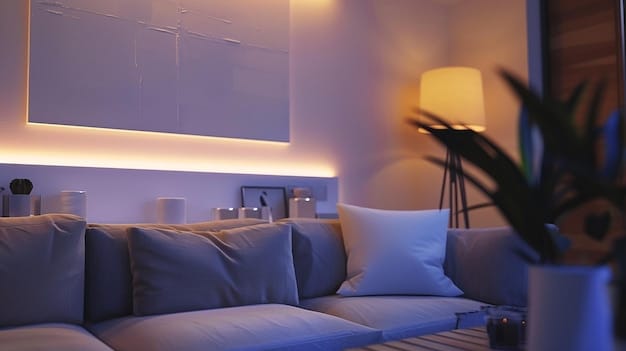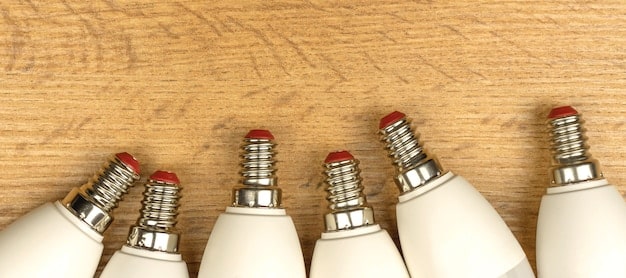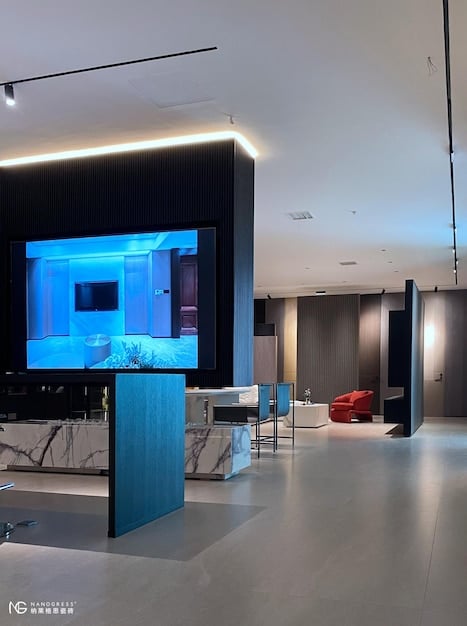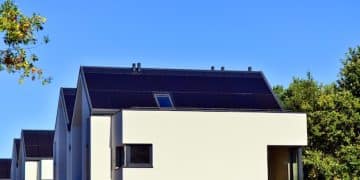Energy-Efficient Lighting: Are LEDs Still the Best Choice in 2025?

In 2025, LED bulbs remain a leading choice for energy-efficient lighting due to their longevity, reduced energy consumption, and decreasing cost, although newer technologies like OLED and smart lighting solutions are emerging as viable alternatives with enhanced features.
Are you questioning whether energy-efficient lighting: are LED bulbs still the best choice in 2025? With rapid advancements in lighting technology, understanding the current landscape is crucial for making informed decisions about your lighting needs.
The Evolution of Energy-Efficient Lighting
The journey toward energy-efficient lighting has been marked by significant technological advancements. From incandescent bulbs to compact fluorescent lamps (CFLs) and now light-emitting diodes (LEDs), each innovation has aimed to reduce energy consumption and environmental impact.
Understanding this evolution provides context for assessing whether LEDs remain the best option in 2025. What were the limitations of older technologies, and how have LEDs addressed these issues?
The Rise and Fall of Incandescent and CFL Bulbs
Incandescent bulbs, while providing warm light, were incredibly inefficient, converting only about 5% of their energy into light and the rest into heat. CFLs emerged as a more efficient alternative, but they contained mercury and had issues with light quality and lifespan.
- Incandescent Bulbs: Inefficient, short lifespan, high energy consumption.
- CFLs: More efficient than incandescent but contain mercury and have slower startup times.
- Halogen Bulbs: Improved incandescent technology but still less efficient than LEDs.
LEDs, with their superior energy efficiency and lack of hazardous materials, quickly gained popularity. They offered a longer lifespan, better light quality, and lower energy consumption, making them a compelling choice for consumers and businesses alike.

Advantages of LED Bulbs in 2025
As we approach 2025, LED bulbs continue to offer numerous advantages. However, it’s essential to examine these benefits in the context of newer, emerging technologies. What makes LEDs still relevant, and where might they be surpassed?
The core advantages of LEDs include energy efficiency, longevity, and versatility. Let’s delve into each of these aspects to understand why LEDs remain a strong contender in the lighting market.
Energy Efficiency and Cost Savings
LEDs consume significantly less energy than traditional lighting technologies. This translates to substantial cost savings on electricity bills over time. How do these savings compare to other energy-efficient options?
LEDs can reduce energy consumption by up to 80% compared to incandescent bulbs. This efficiency directly lowers electricity costs and reduces the strain on power grids. Furthermore, the long lifespan of LEDs means fewer replacements, further saving money and resources.
Longevity and Reduced Maintenance
One of the standout features of LEDs is their extended lifespan. This reduces the frequency of bulb replacements, saving time and maintenance costs. How does this longevity impact long-term sustainability?
- Long Lifespan: LEDs can last up to 25 times longer than incandescent bulbs.
- Reduced Maintenance: Fewer replacements mean lower maintenance costs.
- Environmental Benefits: Less frequent disposal reduces waste.
The long lifespan of LEDs not only saves money but also minimizes environmental impact. By reducing the number of bulbs that end up in landfills, LEDs contribute to a more sustainable lighting solution.
Emerging Competitors: OLED and Smart Lighting
While LEDs have dominated the energy-efficient lighting market, new technologies are emerging as potential competitors. Organic light-emitting diodes (OLED) and smart lighting systems are gaining traction.
Understanding these alternatives is crucial for determining whether LEDs will maintain their dominance. What do OLED and smart lighting offer, and where do they fall short compared to LEDs?

The Potential of OLED Technology
OLED technology offers unique advantages, such as thin, flexible panels and diffuse light emission. How does OLED compare to LED in terms of efficiency, cost, and applications?
OLEDs produce light through a different mechanism than LEDs, allowing for more uniform and glare-free illumination. This can be particularly beneficial in applications where aesthetics and visual comfort are paramount. However, OLEDs are currently more expensive and less efficient than LEDs.
Smart Lighting and IoT Integration
Smart lighting systems integrate with the Internet of Things (IoT), allowing for advanced control and automation. How does smart lighting enhance energy efficiency and user experience?
- Remote Control: Adjust lighting settings from anywhere using a smartphone or tablet.
- Automation: Program lighting schedules to optimize energy usage.
- Integration with Smart Home Systems: Seamlessly connect with other smart devices for a cohesive home automation experience.
Smart lighting can further improve energy efficiency by adjusting light levels based on occupancy and ambient light. Integration with smart home systems allows for personalized lighting experiences tailored to individual preferences.
Cost Analysis: LEDs vs. Alternatives
Cost is a significant factor when choosing lighting solutions. A thorough cost analysis should consider not only the initial purchase price but also long-term energy savings and maintenance costs. Do LEDs still offer the best value for money in 2025?
Comparing the costs of LEDs, OLEDs, and traditional lighting options requires a comprehensive approach. Let’s examine the upfront costs, energy consumption, lifespan, and potential rebates to determine the most cost-effective choice.
Upfront Costs and Long-Term Savings
While LEDs may have a higher upfront cost than traditional bulbs, their long lifespan and energy efficiency result in significant savings over time. How do these savings compare to the initial investment?
- Initial Investment: LEDs generally have a higher purchase price.
- Energy Savings: Lower electricity bills due to reduced energy consumption.
- Lifespan Comparison: LEDs last much longer, reducing replacement costs.
The long-term savings from reduced energy consumption and fewer replacements often outweigh the higher initial cost of LEDs. This makes them a cost-effective choice for both residential and commercial applications.
Environmental Impact and Sustainability
Environmental considerations are increasingly important when making purchasing decisions. How do LEDs compare to other lighting technologies in terms of environmental impact and sustainability?
Assessing the environmental footprint of lighting solutions involves considering energy consumption, material usage, and waste generation. Let’s explore how LEDs contribute to a more sustainable future.
Reduced Energy Consumption and Carbon Footprint
LEDs consume less energy, which translates to a smaller carbon footprint. How does this reduction contribute to mitigating climate change?
By reducing energy consumption, LEDs help lower greenhouse gas emissions from power plants. This makes them a vital tool in the fight against climate change. Additionally, the long lifespan of LEDs reduces waste and the need for raw materials.
Future Trends in Energy-Efficient Lighting
The field of energy-efficient lighting is continually evolving. What trends can we expect to see in the coming years, and how will these advancements impact the lighting market?
Exploring future trends provides insights into the potential direction of lighting technology. Let’s examine developments in LED technology, smart lighting, and emerging materials.
Advancements in LED Technology
LED technology continues to improve, with ongoing research focused on increasing efficiency, reducing costs, and enhancing light quality. What innovations can we anticipate in the near future?
Researchers are working to develop more efficient LEDs that produce brighter light with less energy. Improvements in color rendering and light distribution will also enhance the user experience. Additionally, advancements in manufacturing processes are expected to lower the cost of LEDs.
| Key Point | Brief Description |
|---|---|
| 💡 Energy Efficiency | LEDs consume up to 80% less energy than incandescent bulbs. |
| ⏳ Longevity | LEDs last significantly longer, reducing replacements. |
| 🌱 Environmental Impact | Lower carbon footprint due to reduced energy consumption. |
| 💰 Cost Savings | Reduced electricity bills and lower maintenance costs. |
FAQ
Yes, LEDs generally have a higher upfront cost, but their longevity and lower energy consumption lead to significant long-term savings, making them a cost-effective choice over time.
LED bulbs can last up to 25 times longer than incandescent bulbs, often ranging from 25,000 to 50,000 hours, which significantly reduces the frequency of replacements.
Yes, LEDs are more environmentally friendly. They consume less energy, reducing the carbon footprint, and do not contain hazardous materials like mercury, making them safer for disposal.
Most LED bulbs are designed to be compatible with standard fixtures, but it’s essential to check the bulb’s specifications to ensure compatibility with dimmers or enclosed fixtures for optimal performance.
Smart lighting systems offer remote control, automation, and integration with other smart home devices, enhancing energy efficiency and providing personalized lighting experiences tailored to individual preferences.
Conclusion
In 2025, **energy-efficient lighting: are LED bulbs still the best choice?** While emerging technologies like OLED and smart lighting offer promising alternatives, LEDs remain a top contender due to their proven energy efficiency, longevity, and decreasing cost. As technology evolves, staying informed about the latest advancements will help you make the best lighting decisions for your needs.





